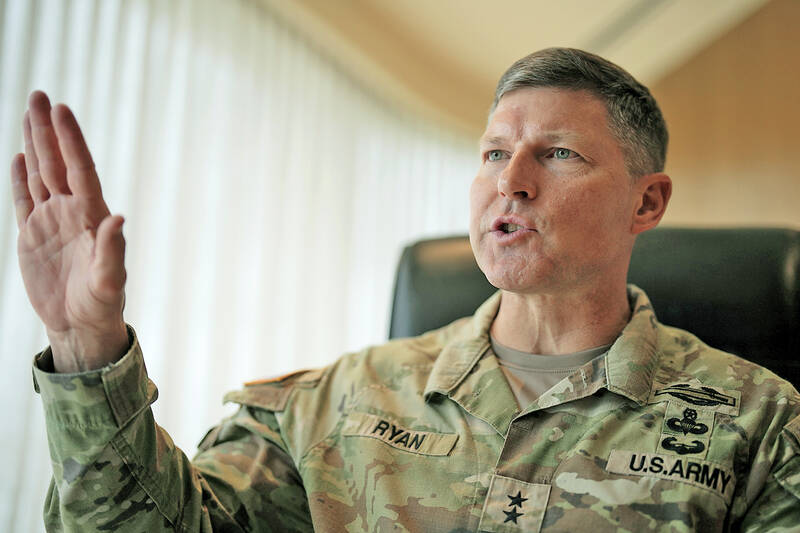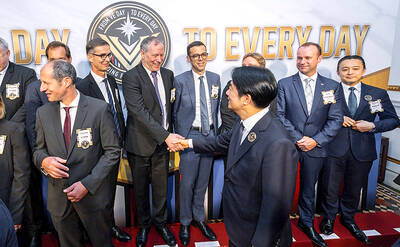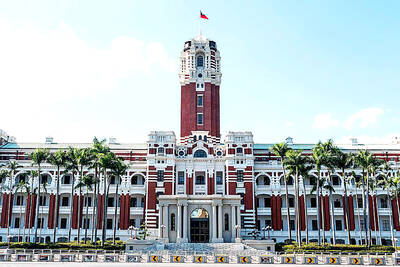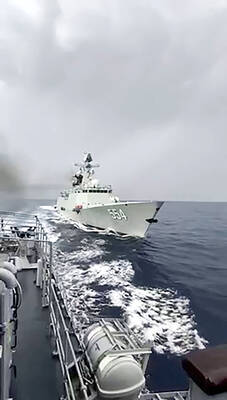US forces and their allies in Asia are ready for battle after years of joint combat exercises, a US general said on Wednesday, adding that Russia’s setbacks in Ukraine should serve as a warning to potential Asian aggressors like China and North Korea.
US treaty allies like the Philippines, Japan and Australia, among others, “have shown that they will band together, that they will not stand for aggression from these nations that have decided they want to change the world order out here,” US Major General Joseph Ryan said.
Although Asia has no counterpart to NATO, the 30-nation military alliance whose mostly European members vow to defend each other against external attacks, a network of US treaty alliances and defense partnerships upholding the international order provides a regional safeguard, he said.

Photo: AP
“I’m personally very buoyed by what I see by our allies and partners in this region and the way we’ve come together in response to aggression by the PRC, by North Korea to say: ‘We will not let that stand,’” Ryan told The Associated Press in an interview on Wednesday, using the acronym for China’s official name, the People’s Republic of China.
Ryan, commanding general of the US Army’s 25th Infantry Division based in Hawaii, is in Manila partly for talks with Philippine counterparts ahead of two annual large-scale combat exercises that would include live-fire exercises and ground, sea and air assault maneuvers involving thousands of US and Philippine troops next month and in April.
The Philippines, the US’ oldest treaty ally in Asia that used to host the largest US naval and air force bases outside the US mainland, has allowed larger numbers of visiting US forces to stay in rotating batches and preposition weapons and combat equipment in at least nine Philippine military camps under a 2014 defense pact.
The Philppine decision to allow a broader US military presence was announced during a visit last week to Manila by US Secretary of Defense Lloyd Austin.
In the broader Asia-Pacific region, Washington has reinforced an arc of alliances to counter what it says are threats posed by an increasingly belligerent China and North Korea.
The US and the Philippines have agreed to hold about 500 small and major combat exercises this year, and expand annual military drills following disruptions caused by two years of COVID-19 lockdowns, Philippine military officials have said.
Asked if US forces and their Asian allies were ready to respond if a major crisis similar to Russia’s invasion of Ukraine breaks out in the region, Ryan said: “Absolutely.”
“I’m very comfortable that we’re ready, but that doesn’t mean I’m satisfied. We can always get better,” he said.
“I think our allies in the region value their sovereignty, value their freedom, value their independence. And no adversary should take that lightly,” Ryan said.

DEFENDING DEMOCRACY: Taiwan shares the same values as those that fought in WWII, and nations must unite to halt the expansion of a new authoritarian bloc, Lai said The government yesterday held a commemoration ceremony for Victory in Europe (V-E) Day, joining the rest of the world for the first time to mark the anniversary of the end of World War II in Europe. Taiwan honoring V-E Day signifies “our growing connections with the international community,” President William Lai (賴清德) said at a reception in Taipei on the 80th anniversary of V-E Day. One of the major lessons of World War II is that “authoritarianism and aggression lead only to slaughter, tragedy and greater inequality,” Lai said. Even more importantly, the war also taught people that “those who cherish peace cannot

STEADFAST FRIEND: The bills encourage increased Taiwan-US engagement and address China’s distortion of UN Resolution 2758 to isolate Taiwan internationally The Presidential Office yesterday thanked the US House of Representatives for unanimously passing two Taiwan-related bills highlighting its solid support for Taiwan’s democracy and global participation, and for deepening bilateral relations. One of the bills, the Taiwan Assurance Implementation Act, requires the US Department of State to periodically review its guidelines for engagement with Taiwan, and report to the US Congress on the guidelines and plans to lift self-imposed limitations on US-Taiwan engagement. The other bill is the Taiwan International Solidarity Act, which clarifies that UN Resolution 2758 does not address the issue of the representation of Taiwan or its people in

Taiwanese Olympic badminton men’s doubles gold medalist Wang Chi-lin (王齊麟) and his new partner, Chiu Hsiang-chieh (邱相榤), clinched the men’s doubles title at the Yonex Taipei Open yesterday, becoming the second Taiwanese team to win a title in the tournament. Ranked 19th in the world, the Taiwanese duo defeated Kang Min-hyuk and Ki Dong-ju of South Korea 21-18, 21-15 in a pulsating 43-minute final to clinch their first doubles title after teaming up last year. Wang, the men’s doubles gold medalist at the 2020 and 2024 Olympics, partnered with Chiu in August last year after the retirement of his teammate Lee Yang

The Philippines yesterday criticized a “high-risk” maneuver by a Chinese vessel near the disputed Scarborough Shoal (Huangyan Island, 黃岩島) in a rare incident involving warships from the two navies. The Scarborough Shoal — a triangular chain of reefs and rocks in the contested South China Sea — has been a flash point between the countries since China seized it from the Philippines in 2012. Taiwan also claims the shoal. Monday’s encounter took place approximately 11.8 nautical miles (22km) southeast” of the Scarborough Shoal, the Philippine military said, during ongoing US-Philippine military exercises that Beijing has criticized as destabilizing. “The Chinese frigate BN 554 was